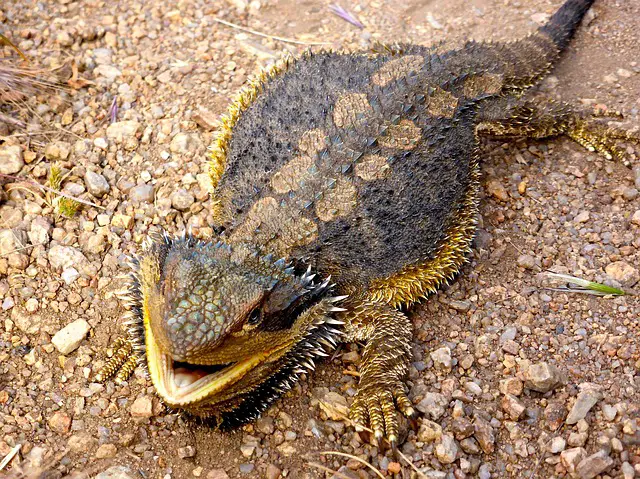There are a lot of debates over what is the best material to use for a bearded dragon habitat. Some people swear by using felt, while others think it’s a terrible idea. So, what’s the truth? Can you use felt for the bearded dragon habitat? The answer is…it depends.
Can you use felt for a bearded dragon?
If you’re using felt as the only material in your dragon’s habitat, then the answer is no. Felt isn’t a good substrate for bearded dragons because it can become moldy and lead to respiratory problems.
But if you’re using felt like part of a more complex setup, with other materials like paper towels or reptile carpets, then it’s okay. Felt can be a good way to add some humidity to your dragon’s habitat, and it’s also soft and comfortable for them to walk on.
Just make sure that you keep an eye on the felt to make sure it doesn’t get too wet or start growing mold. And if you ever see any signs of respiratory problems in your dragon, take them to the vet right away.
The Pros and Cons of felt for Bearded Dragons
Bearded dragons make popular pets, in part because they are easy to care for. One of the most important aspects of caring for a bearded dragon is providing an appropriate habitat. Some people choose to use felt as the substrate for their bearded dragon’s habitat. Let’s take a closer look at the pros and cons of using felt as a substrate for bearded dragons.
Pros:
-Felt is soft, so it is comfortable for bearded dragons to walk on and sit on.
-Felt helps keep the habitat clean by absorbing urine and feces.
-Felt can be easily cleaned and replaced when it becomes dirty.
Cons:
-Some people worry that felt may cause respiratory problems in bearded dragons due to the dust it creates.
-Felt can be a fire hazard if it is not treated with a flame retardant.
-Some people believe that felt can cause health problems in bearded dragons, such as skin lesions and intestinal blockages.
The drawbacks of using felt for a Bearded Dragon
One of the main drawbacks of using felt for a Bearded Dragon is that it does not provide adequate ventilation. Felt also does not allow for proper drainage, which can lead to health problems for your bearded dragon. In addition, felt is not a very durable material and can easily tear. If you are considering using felt for your bearded dragon’s habitat, it is important to weigh the pros and cons carefully.
What are the best substrates for Bearded Dragon Habitat?
There are many types of substrates that you can use for your bearded dragon’s habitat. The most popular options include sand, paper towels, and reptile carpet. You can also use a variety of other materials such as wood chips, AstroTurf, or felt. When choosing a substrate, make sure to pick something that is safe and comfortable for your pet.
Sand is a popular option because it is safe and easy to clean. It also helps keep the habitat warm. However, you should avoid using sand if your bearded dragon has a tendency to eat substrate.
Paper towels are another safe and easy-to-clean option. They are also relatively affordable. Reptile carpet is a good option if you want something that looks more natural. It is also easy to clean and relatively affordable.
View reptile carpet on Amazon Here
Conclusion
If you are looking for something more natural, you can try using wood chips or AstroTurf. These options are safe and look more like the bearded dragon’s natural habitat. However, they can be more difficult to clean.
No matter what type of substrate you choose, make sure to keep an eye on your pet and regularly clean their habitat. This will help keep your bearded dragon healthy and happy.
FAQ
Q. Can I use felt for my bearded dragon’s habitat?
A. Yes, you can use felt for your bearded dragon’s habitat. It is a safe and comfortable substrate that your pet will enjoy. Make sure to clean the habitat regularly to keep your bearded dragon healthy and happy.
Q. What are some other safe substrates that I can use for my pet?
A. There are many types of safe substrates that you can use for your pet. Some popular options include sand, paper towels, reptile carpet, wood chips, AstroTurf, and felt. Choose the substrate that best suits your needs and preferences. Just make sure to keep an eye on your pet and regularly clean their habitat to ensure their health and well-being.
Q. How often should I clean my bearded dragon’s habitat?
A. You should clean your bearded dragon’s habitat regularly to ensure their health and happiness. Depending on the substrate you use, cleaning may be as simple as spot-cleaning or changing the paper towels. More difficult substrates, such as sand or wood chips, may require a more thorough cleaning. No matter what type of substrate you use, make sure to keep their habitat clean to provide a healthy environment for your pet.
Q. What are some things I should avoid using for my bearded dragon’s habitat?
A. There are many things that you should avoid using for your bearded dragon’s habitat. Some common materials to avoid include glass, plastic, metal, and anything that can be easily chewed or ingested. You should also avoid using any type of substrate that your pet might eat, such as sand. If you are unsure whether a material is safe for your pet, consult with your veterinarian.




